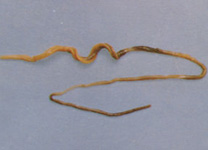Huang Island Long-snouted Worm, with its Latin name known as Saccoglossus hwangtauensis, is a member of the Harrlmaniidae family of Enteropneusta order. It is reputed as "long-snouted worm" for having relatively long snout, the length of which is about 1/20 of the full length. As a specific invertebrate native to China, it is mainly distributed in the sea area near Jiaozhou Bay of Shandong Province in the north of China.
 |
|
It is soft and slender with a full length of 300 millimeters, in the shape of a worm. Its snout section is in the shape of oblate cone, with a strip of apparent or unapparent longitudinal groove in the centre line of both sides. From base to tip, the snout is separated by the groove into two parts -- the left and the right. Its collar section is wide and short, with a strip of ring-shaped dent in the lower part, of which the surface is smooth and the length is only 1/100 of full length. Both snout and collar sections are in the color of light orange. Its tail, in the shape of cylinder, is in the color of greenish yellow except for the yellow tail end.
It has a developed branchia reproduction section, occupying the 2/3 of full length. The front and rear sections of genital alae are lower, appearing like two strips of thin and ridgy back, with a relatively higher middle part. The forepart of the genital alae is light orange, while the lower part is greenish brown. The hepatic caecal section is also greenish brown. There are two strips of light colored ridges between the back of front body and genital alae. The two ridges part at the front with relatively large space, but get more and more closer as they extending backwards, and finally get connected at the tail end, forming a ">" shape. There is a line of small opercular apertures on the exterior margin of each ridged back, and the number of opercular apertures is about 90 couples.
It dwells in silver sand beaches and silt beaches of middle and low tidal regions. Its hideouts are in the form of "U". Its entire body lies crossly in the hole, the opening of which is rather wide and funnel-shaped with a depth of 50 to 20 centimeters. Because its body wall contains substantive Iodine, the iodic smell can be nosed in the region where it is densely distributed.
